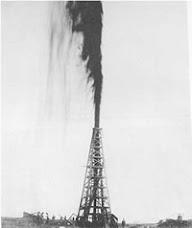
HK’s Strategy: Petrohawk (HK) is rapidly converting to a company focused on exploiting (drilling) already acquired leases in two shale plays: The Haynesville/Lower Bossier play and the Eagle Ford play.
In 2009, Petrohawk spent $450 million on new leases, which now need to be drilled. HK has so much Haynesville acreage that they are drilling to hold leases rather than drilling safe PUD (proven undeveloped) locations.
To get more money for drilling these two new unconventional (meaning horizontal drilling) plays, Petrohawk is selling (divesting or monetizing) large parts of Hawkfield Services and all its conventional production. This shuffling of the deck is fairly common among very fast independent petroleum exploration and production (E&P) companies.
Haynesville/Lower Bossier Shales: The Haynesville/Bossier gas play (Louisiana and Texas) is Petrohawk’s largest exploration target. Petrohawk has 360,000 net acres leased in the Haynesville play and claim that they own the 60,000 acre core (the best acreage) in northwest Louisiana.
In 2010, HK will spend 62% of its drilling budget and 85% of its midstream budget on the Haynesville. They are betting the farm on the Haynesville, but it looks like a safe bet.
Petrohawk has budgeted 17 of it 24 drilling rigs to exploit the Haynesville. The gas wells that Petrohawk is drilling are very large and extremely profitable producers. In 2009, they drilled 64 new Haynesville producers, which averaged an initial production (IP) rate of 17.8 MMCFD (million cubic feet of gas per day), and which will pay for themselves within one year.
In 2010, the 17-drilling rig program will drill 110-120 operated Haynesville wells.
HK’s cost per well in the Haynesville has declined mostly due to drilling faster. Petrohawk’s 2009 cost per Haynesville well was $10.5 million; 2010 cost per well is expected to be $9.5 million. The “learning curve” in new plays like the Haynesville yields cheaper wells with higher yields as operators learn the most efficient and effective ways to drill and complete the wells.
The Lower Bossier Shale, lies 200 feet above the Haynesville is even a newer play. HK has 1220,000 net acres that are potentially economic in the Lower Bossier Shale.
Petrohawk’s hot Lower Bossier Whitney Prospect is apparently on the Texas side of the play; HK’s first Lower Bossier test will be in the first quarter of 2010. Petrohawk is delaying Lower Bossier drilling while Hawkfield Services builds midstream (gas-gathering and gas processing infrastructure) in the area.
Leasing Stopped: Petrohawk has stopped almost all their leasing. They still are doing a little leasing in Eagle Ford, and some mop up leasing in the Haynesville/Lower Bossier, especially in the SW extension, which is the Lower Bossier core.
Midstream Hawkfield Services: 85% of Petrohawk’s midstream budget for 2010 is for the Haynesville play; the other 15% is for Eagle Ford. Midstream refers (1) to the processing plants that strip valuable liquids from natural gas, and (2) to the gas-gathering lines that connect wells to these processing plants. Without midstream, natural gas cannot be sold to the large gas pipeline companies.
Large gas explorers, like Petrohawk, often build their own midstream systems in new gas plays such as the Haynesville. This helps get their wells “on line” (selling gas to pipelines) faster.
Petrohawk’s midstream is known as Hawkfield Services. Midstream is often very profitable, especially in new plays such as the Haynesville. However, Petrohawk’s new Haynesville and Eagle Ford wells are even more profitable. Thus, Petrohawk is trying to sell part of their Hawkfield Services in the Haynesville in order to reinvest the money to drill more gas wells.
Eagleford Shale Shale (310,000 net acres): Hawkville pioneered the new Eagle Ford Shale play in South Texas and has two very large, solid blocks of acreage: Hawkville Field, and Redhawk Field.
As the pioneer, Petrohawk was able to acquire their acreage at very low costs.
HK will spend 24% of its drilling budget and 15% of its midstream budget in the Eagle Ford Shale.
Hawkville Field (in LaSalle and McMullen Counties) is ready for intensive drilling and connecting to gas sales. HK considers this field to be derisked, and will use 6 drilling rigs here in 2010.
The 22 wells that HK has drilled so far in Hawkville Field cost less than $5 million each to drill, complete, and connect. Each has averaged 10.4 MMCFD. HK is still on the learning curve in Eagle Ford and with improvement – such as longer laterals (longer horizontal sections), better stimulation, etc. – future wells will continue to get better.
Redhawk Field: HK has drilled the first Redhawk wildcat and is waiting on stimulation (fracing) treatment. Petrohawk says Redhawk is an oil prospect, which potentially makes it a hotter prospect than Hawkville.
Fayetteville Shale (157,000 net acres): Petrohawk has deemphasized this play and will commit only one drilling rig here in 2010. HK’s leases here are held by production, and thus do not face the expiration problems that their leases in the
Haynesville/Lower Bossier and Eagle Ford face.
HK’s Fayettville Shale assets are not up for sale, but they would sell them. They plan on moving more rigs into this play in mid-2011.
Petrohawk’s Hedging: Most petroleum exploration and production firms hedge their oil and natural gas. They must have money to drill new wells and they (and especially their bankers) are not willing to take chances on fluctuating oil and gas prices.
Petrohawk has 68% of expected 2010 natural gas production hedged, and 50% of its 2011 natural gas production hedged.
News we’re looking for:
1. Initial production rate of the Redhawk wildcat. Could be anytime after March 1st.
2. Divesture progress report; promised to us by mid year.

No comments:
Post a Comment